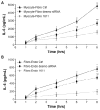Desmoplakin is important for proper cardiac cell-cell interactions
- PMID: 22152112
- PMCID: PMC3328415
- DOI: 10.1017/S1431927611012359
Desmoplakin is important for proper cardiac cell-cell interactions
Abstract
Normal cardiac function is maintained through dynamic interactions of cardiac cells with each other and with the extracellular matrix. These interactions are important for remodeling during cardiac growth and pathophysiological conditions. However, the precise mechanisms of these interactions remain unclear. In this study we examined the importance of desmoplakin (DSP) in cardiac cell-cell interactions. Cell-cell communication in the heart requires the formation and preservation of cell contacts by cell adhesion junctions called desmosome-like structures. A major protein component of this complex is DSP, which plays a role in linking the cytoskeletal network to the plasma membrane. Our laboratory previously generated a polyclonal antibody (1611) against the detergent soluble fraction of cardiac fibroblast plasma membrane. In attempting to define which proteins 1611 recognizes, we performed two-dimensional electrophoresis and identified DSP as one of the major proteins recognized by 1611. Immunoprecipitation studies demonstrated that 1611 was able to directly pulldown DSP. We also demonstrate that 1611 and anti-DSP antibodies co-localize in whole heart sections. Finally, using a three-dimensional in vitro cell-cell interaction assay, we demonstrate that 1611 can inhibit cell-cell interactions. These data indicate that DSP is an important protein for cell-cell interactions and affects a variety of cellular functions, including cytokine secretion.
Figures






Similar articles
-
Cardiac Fibro-Adipocyte Progenitors Express Desmosome Proteins and Preferentially Differentiate to Adipocytes Upon Deletion of the Desmoplakin Gene.Circ Res. 2016 Jun 24;119(1):41-54. doi: 10.1161/CIRCRESAHA.115.308136. Epub 2016 Apr 27. Circ Res. 2016. PMID: 27121621 Free PMC article.
-
Desmoplakin Maintains Transcellular Keratin Scaffolding and Protects From Intestinal Injury.Cell Mol Gastroenterol Hepatol. 2022;13(4):1181-1200. doi: 10.1016/j.jcmgh.2021.12.009. Epub 2021 Dec 17. Cell Mol Gastroenterol Hepatol. 2022. PMID: 34929421 Free PMC article.
-
Desmoplakin is required for epidermal integrity and morphogenesis in the Xenopus laevis embryo.Dev Biol. 2019 Jun 15;450(2):115-131. doi: 10.1016/j.ydbio.2019.03.010. Epub 2019 Mar 29. Dev Biol. 2019. PMID: 30935896 Free PMC article.
-
Dynamic cell-cell and cell-ECM interactions in the heart.J Mol Cell Cardiol. 2014 May;70:19-26. doi: 10.1016/j.yjmcc.2013.10.006. Epub 2013 Oct 17. J Mol Cell Cardiol. 2014. PMID: 24140801 Review.
-
Communication signals between cardiac fibroblasts and cardiac myocytes.J Cardiovasc Pharmacol. 2011 May;57(5):513-21. doi: 10.1097/FJC.0b013e31821209ee. J Cardiovasc Pharmacol. 2011. PMID: 21297490 Review.
Cited by
-
Pressure overload induces early morphological changes in the heart.Am J Pathol. 2012 Oct;181(4):1226-35. doi: 10.1016/j.ajpath.2012.06.015. Epub 2012 Sep 4. Am J Pathol. 2012. PMID: 22954422 Free PMC article.
-
Introduction: Extracellular matrix and cardiovascular remodeling-using microscopy to delineate mechanisms.Microsc Microanal. 2012 Feb;18(1):1-2. doi: 10.1017/S1431927611012761. Microsc Microanal. 2012. PMID: 22258720 Free PMC article. No abstract available.
-
Adeno-associated virus-based approach for genetic modification of cardiac fibroblasts in adult rat hearts.Physiol Rep. 2024 Mar;12(6):e15989. doi: 10.14814/phy2.15989. Physiol Rep. 2024. PMID: 38538007 Free PMC article.
-
Genetics of Cardiac Aging Implicate Organ-Specific Variation.medRxiv [Preprint]. 2024 Aug 6:2024.08.02.24310874. doi: 10.1101/2024.08.02.24310874. medRxiv. 2024. PMID: 39148824 Free PMC article. Preprint.
-
Myocyte-fibroblast communication in cardiac fibrosis and arrhythmias: Mechanisms and model systems.J Mol Cell Cardiol. 2016 May;94:22-31. doi: 10.1016/j.yjmcc.2016.03.005. Epub 2016 Mar 18. J Mol Cell Cardiol. 2016. PMID: 26996756 Free PMC article. Review.
References
-
- Asimaki A, Syrris P, Ward D, Guereta LG, Saffitz JE, McKenna WJ. Unique epidermolytic bullous dermatosis with associated lethal cardiomyopathy related to desmoplakin mutations. J Cutan Pathol. 2009;36:553–559. - PubMed
-
- Banerjee I, Yekkala K, Borg TK, Baudino TA. Dynamic interactions between myocytes, fibroblasts and extra-cellular matrix. Ann NY Acad Sci. 2006;1080:76–84. - PubMed
-
- Baudino TA, McFadden A, Fix C, Hastings J, Price R, Borg TK. Cell patterning: Interaction of cardiac myocytes and fibroblasts in three-dimensional culture. Microsc Microanal. 2008;14:117–125. - PubMed
-
- Bierkamp C, Mclaughlin KJ, Schwarz H, Huber O, Kemler R. Embryonic heart and skin defects in mice lacking plakoglobin. Dev Biol. 1996;180:780–785. - PubMed
-
- Borg KT, Burgess W, Terracio L, Borg TK. Expression of metalloproteases by cardiac myocytes and fibro-blasts in vitro. Cardiac Pathol. 1997;6:261–269. - PubMed
Publication types
MeSH terms
Substances
Grants and funding
LinkOut - more resources
Full Text Sources
Miscellaneous

